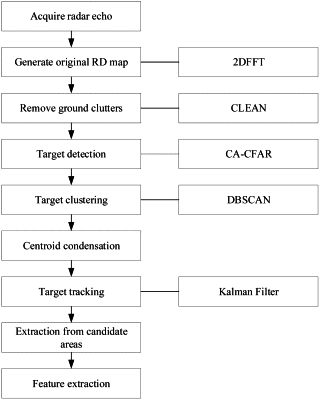| CPC G01S 13/449 (2013.01) [G01S 7/354 (2013.01); G01S 7/356 (2021.05); G01S 7/414 (2013.01)] | 7 Claims |

|
1. A method of target feature extraction based on millimeter-wave radar echo, comprising:
(1) Measured target data based on millimeter-wave radar is obtained, and an original Range Doppler RD map of targets is generated by using the measured data;
(2) Ground clutter in the original Range Doppler RD map of the targets is removed;
(3) An improved cell-averaging CFAR algorithm is used to detect the targets on the RD map with clutter removed:
(3a) A cell to be detected is selected, and energy average values of several adjacent reference cells to the left of, to the right of, on top of, and below the cell to be detected are calculated;
(3b) According to specific experimental scenes and conditions, a threshold is set by using the energy average values obtained in (3a), so as to compare the energy of the current cell to be detected with the threshold, wherein: if the energy of the cell to be detected is greater than or equal to the threshold, the cell is determined to be a target and its coordinate is recorded, otherwise the cell is dismissed;
(3c) Operations (3a) and (3b) are performed on all pixels in the RD map to obtain all detected target points in the RD map;
(4) Detected targets are clustered by using a density-based spatial clustering of applications with noise (DBSCAN) algorithm, and then centroid condensation is performed on the clustered targets;
(5) (1) to (4) are repeated to obtain a continuous multi-frame RD maps;
(6) A Kalman filtering method is used for tracking targets on the continuous multi-frame RD maps obtained in (5), and candidate areas on each RD map are selected according to the obtained tracking trajectories;
(7) Features are extracted from the candidate areas:
(7a) Features are extracted from each of the continuous multi-frame RD maps:
By setting a threshold and filtering out noise with principal components and secondary components of the targets left, 10 features are extracted from the threshold-crossing RD map, including range dimension extension ΔL, velocity dimension extension ΔV, number of threshold-crossing points N, total energy SE, principal component energy ME, principal component proportion MP, secondary component mean value VEA, secondary component variance VEV, secondary component standard deviation VES and entropy E;
(7b) Features are extracted from two successive RD maps of the continuous multi-frame RD maps:
(7b1) By setting a threshold and filtering out noise with principal components and secondary components of the targets left, the features same as those of (7a) are extracted from two successive RD maps, subjected to the filtering, of the continuous multi-frame RD maps, respectively;
(7b2) By virtue of the features extracted in (7b1), the difference is calculated between the corresponding features of the two successive RD maps, and 12 features are obtained, including principal component range dimension variation MLC, principal component velocity dimension variation MVC, range dimension extension variation ΔLC, velocity dimension extension variation ΔVC, scattering point number variation NC, total energy variation SEC, principal component energy variation MEC, principal component proportion variation MPC, secondary component mean value variation VEAC, secondary component variance variation VEVC, secondary component standard deviation variation VESC and entropy variation EC;
(7b3) The two successive RD maps subjected to the threshold-crossing operation in (7b1) are aligned for subtracting to obtain an absolute value to form a difference matrix, from which 8 features are extracted, including the number of energy generation change points M, the total energy of the difference matrix SDE, the mean value of energy change at each point DEA, the difference matrix variance DV, the standard deviation of the difference matrix DS, the entropy of the difference matrix DE, the range dimension extension of the difference matrix ΔW and the velocity dimension extension of the difference matrix ΔD and;
(8) The extracted features of the continuous multi-frame RD maps are inputted into a random forest classifier for classification, to output classification results of the targets.
|